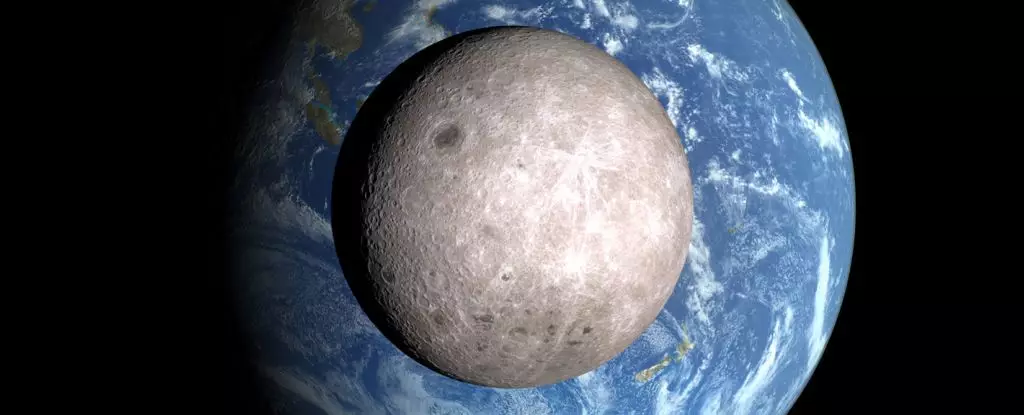The Moon, Earth’s celestial companion, holds many secrets, and recent findings about its water distribution reveal even more profound mysteries. Contrary to what one might expect from a uniformly shaped celestial body, lunar analyses indicate a significant water imbalance between its two hemispheres. The near side, always facing Earth, is rich in water-holding materials, while the far side presents an arid landscape, raising questions that go beyond simple space curiosities. This disparity is not merely a trivial detail; it could hold the key to understanding the Moon’s formation and the history of our early Solar System.
The data comes primarily from lunar materials collected by China’s Chang’e-6 mission—the first mission to retrieve samples from the far side. These samples show that the lunar crust is markedly different depending on which side you’re looking at. While the Earth-facing side is characterized by flat, basaltic plains, the far side boasts a rugged landscape riddled with craters, revealing a history defined not only by volcanic activity but also by the absence of it on one side. The implications of this divide are not only perplexing but foundational to our understanding of planetary formation.
The Role of the Giant Impact Hypothesis
At the core of the discussion about the Moon’s uneven landscape lies the Giant Impact Hypothesis, which posits that a Mars-sized body named Theia collided with the early Earth over 4.5 billion years ago. This cataclysmic event sent debris into orbit that eventually coalesced to form the Moon. One might intuitively expect that such a formative event would ensure a uniform distribution of resources across the Moon. However, the stark differences between the two hemispheres pose an intriguing dilemma.
Scientists propose that the warmer environment of the near side allowed for more extensive volcanic activity, resulting in the smooth basalt plains we see today. In contrast, the far side’s cooler temperature and thicker crust have hampered similar geological processes, leading to a starkly different terrain. This hypothesis, backed by geological analysis, highlights an essential contrast between the two sides of our Moon—one side bathed in volcanic vigor and the other relegated to a quieter, more stolid existence.
Water: The Elusive Resource
Water plays a critical role in the geological and chemical processes that define celestial bodies, and its scarcity on the far side of the Moon adds another layer of complexity. Preliminary analyses suggest that the lunar mantle reveals a startlingly wide range of water concentration, from merely 1 microgram to as much as 200 micrograms per gram of material. The Chang’e-6 mission, however, unearthed evidence that the magma forming the South Pole-Aitken Basin—one of the oldest and largest impact basins on the Moon—contained a meager 1 to 1.5 micrograms per gram of water.
This limited water presence poses questions about past geological activity and volcanic potential on the far side. While one might be quick to attribute this relative dryness to the far side’s geological characteristics, it beckons a deeper analysis. It raises the hypothesis that there may be more aqueous variations hidden within those far-side depths, just waiting to be discovered. As we push the boundaries of lunar exploration, we realize that we have only scratched the surface of a broader chemical and geophysical narrative.
The Future of Lunar Exploration
The striking asymmetry of the Moon raises serious questions and inspires curiosity, but it also demands more from the scientific community. More samples, further investigations, and sustained missions are essential to piece together this cosmic puzzle. As we prepare for a new era of lunar exploration, including plans for manned missions and potential colonization, we must acknowledge that the Moon’s composition, particularly its water distribution, is essential not just for science, but for any long-term human presence.
Fascinating though the Moon’s water dichotomy may be, it serves a larger purpose. Unlocking its mysteries could yield insights into not just lunar history but also the broader understanding of planetary formation. In an age when space exploration faces both incredible successes and significant setbacks, we must remain committed to further exploration of our closest neighbor, which not only holds secrets about its own origin but also contributes crucially to our understanding of the birth and evolution of Earth itself.
In a world grappling with climate crises and resource scarcity, the Moon’s water patterns may point us to answers about our own planet’s past, present, and future. As we gaze upon the lunar landscape, we should harbor not only intrigue but also a sense of responsibility—every grain of lunar dust we collect is a step closer to understanding our cosmic heritage and, perhaps, the path forward for our own planet.

